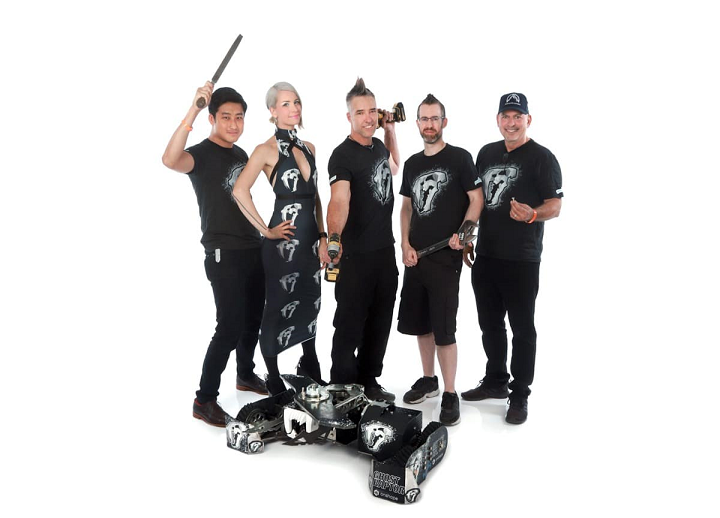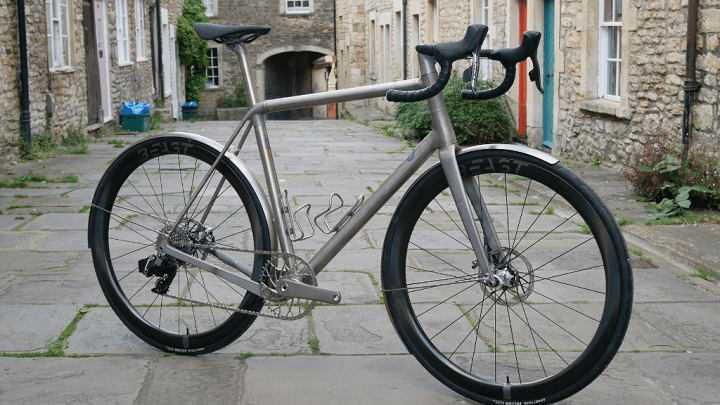3D Printing News Briefs runs the gamut of topics today, as B9Creations has launched a super precise 3D scanner and SuperStile installed the Stratasys F770. A former Stratasys executive has joined the XJet team, Fintek plans on showcasing its AM surface finishing solutions at an event, and titanium parts for a road bike are now being 3D printed with Cold Metal Fusion technology. Finally, Team Raptor’s BattleBot literally shoots fire out of a 3D printed jaw!
B9Creations Launched New 3D Scanner
Professional 3D printing solutions provider B9Creations exhibited at this week’s AGTA GemFair Tucson, and while there announced the launch of its new ultra-precision, intuitive B9 Scan 500 3D scanner, which it calls the “highest-accuracy 3D scanner on the market.” The scanner features a robust internal computer, which enables a customizable and automatic scanning process in which users can replicate models with an accuracy of 5 µm. According to B9Creations, users can scan small objects in less than five minutes with the new B9 Scan 500, which is bundled with Leios 2 software for reliable 3D scan processing, reverse engineering, and mesh editing. The 3D scanner is a good solution for industries from manufacturing to jewelry.
“At B9Creations, we’re always listening to and leveraging feedback to drive product developments, and the B9 Scan 500 was no exception,” said Shon Anderson, the CEO of B9Creations. “We listened to our customers and developed a product that can be leveraged for applications requiring even the highest levels of precision and reliability.”
SuperStile Installs Stratasys F770 to Meet Customer Needs

SuperStile’s industrial-grade FDM-based 3D printing capabilities comprise the Stratasys Fortus 380™ and recently installed F770™
Italian company SuperStile, which partners with automotive brands like BMW and Ferrari for specialty design and manufacturing, increased the capacity of its industrial FDM 3D printing capability by installing a large-format Stratasys F770 3D Printer, in order to meet customer needs for accurate, large parts. The company already had a Stratasys Fortus 380 3D printer, and will now take full advantage of the versatile F770’s fully heated 1000 x 610 x 610 mm build chamber to take on more projects. With its ability to print high-performance ABS-M30 and ASA thermoplastics, soluble support material, and complex internal structures, the system has been installed in SuperStile’s prototyping department, where it’s been used to 3D print models of door handles, air vents, and rear-view mirrors.
“We have selected the F770 for three key reasons. With its mega-build volume, it will ramp up the range of prototyping jobs that we’re able to take on for customers. It also gives us greater production bandwidth across our 3D printing requirements – but importantly via an industrial-grade additive manufacturing technology that has successfully proven itself to us via our Fortus 380,” said SuperStile’s Co-Founder and General Manager Franco Palmisano.
“The purchase of our Stratasys Fortus 380 3D printer in 2021 led to a fundamental change in our mindset and overall approach to our design and development processes, which delivered results very quickly. As well as affording us greater design freedom, we instantly reduced the lead times on prototype production from several weeks to a just a few days, and also decreased overall costs thanks to a much more simplified and cost-effective process.”
XJet Welcomes Andy Middleton to New Role
Speaking of Stratasys, industry leader Andy Middleton, who served as that company’s President for nearly ten years, has been appointed to a new role at Israel-based 3D printing solutions provider XJet. Middleton, who has nearly 30 years of experience in executive positions, most recently as the Executive Vice President at Stratasys, will be a major asset to XJet as its new Business Director for Central Europe. The company, which offers metal and ceramics 3D printing with its NanoParticle Jetting (NPJ) technology, is working to elevate its infrastructure and focusing on its global sales network, and with someone like Middleton helming these efforts in Europe, I predict only good things for XJet’s growth.
“The core technologies behind XJet’s NanoParticle Jetting AM are phenomenal, resulting in groundbreaking material and part properties. This is what it’s all about for customers, essential for high performance ceramics and metal, so I’m excited by the journey XJet is taking,” Middleton said.
“The technical ceramics market is close to tipping point with AM technology, so it’s imperative that highly certified industries such as MedTech, aerospace and energy – that use so many of these materials – understand the potential of XJet’s NanoParticle Jetting technology. A huge amount of compliance is required for these high performing engineering materials, and it’s my opinion XJet is uniquely capable of meeting those criteria with a scalable solution.”
Fintek Showing Automated Surface Finishing Solutions
At the Mach 2022 exhibition in April, Lancashire company Fintek plans to showcase its fully automated surface finishing system for larger components, along with a new electrochemical process for removing support structures from and finishing of internal and external 3D printed part surfaces. The company is looking forward to showing off some improvements that OTEC Präzisionsfinish has made to its range of disc finishing (CF), drag finishing (DR), and stream finishing (SF) machines for smoothing, edge honing, deburring, and polishing. The new process for surface finishing of metal 3D printed components comes from an exclusive deal with another UK company.
“Since the last show, there have been significant advances in surface finishing for traditionally engineered parts and metal components manufactured by 3D printing. From OTEC Präzisionsfinish we have the new SF-HP which brings fully automated high-energy stream finishing to workpieces of 650 mm in diameter and 650 mm long and weighing up to 200 kg. From RENA Technologies, we have the Hirtisation® process that finally resolves one of Additive Manufacturing’s major hindrances, the cost effective and efficient removal of support structures, residues and the smoothing of hard-to-reach internal surfaces and deep cavities,” said Jonathan Dean, Fintek’s Managing Director.
Mach 2022 will be held in Birmingham, April 4-8, and you can visit Fintek at stand 19-26.
Sturdy Cycles Using Cold Metal Fusion AM for Titanium Parts
The speedy, lightweight Fiadh titanium road bike, created by bicycle builder Sturdy Cycles, is now being made with components 3D printed using Cold Metal Fusion (CMF), or Metal SLS, technology by Headmade Materials. The switch is the result of a partnership between Sturdy Cycles, Headmade Materials, and titanium manufacturing specialist Element22. Frame builder Tom Sturdy already had a lot of experience with metal 3D printing, and recognized how much potential CMF could bring to his custom road bicycles, as the technology offers great process stability, repeatability, and efficiency. Additionally, in comparison to SLM printed parts, there is less stress in components made with CMF, and it also offers an improved part surface, which makes surface finishing much easier. Sturdy uses the technology to print the crank arms, chainstay, and connectors for the bike’s frameset, which are welded to polished tubes and accommodate the major components, including the handlebars.
Christian Fischer, Managing Director of Headmade Materials, said, “The production of the components has now been completely taken over by titanium specialist Element22 and we are happy to contribute with our Cold Metal Fusion technology to ensure that these dreamlike road bikes from Sturdy Cycles find their way to many satisfied customers.”
BattleBots’ Ghost Raptor Spits Fire with 3D Printed Jaw

Team Raptor (Chuck Pitzer, Eric Diehr, Sabri Sansoy) teamed up with Designer Anouk Wipprecht and Xo Wang for the 2021 BattleBots competition. Photo by Daniel Longmire.
Finally, for this season of BattleBots, veteran Team Raptor wanted to make its heavyweight Ghost Raptor robot even more amazingly destructive, and partnered with high-tech futurist designer Anouk Wipprecht and metal Directed Energy Deposition (DED) company Formalloy to 3D print a metal jaw that opens up to spit fire at its opponents! The team has been creating robot fighters for more than ten years, and has gotten good at reusing components during redesign to keep costs down. Until now, 3D printing has only been used for prototyping purposes with BattleBots, but as metal AM becomes more accessible, some teams are interested in using the technology to create actual BattleBot parts. The team reached out to Wipprecht, who’s a big fan of robots, and she joined them in their endeavor to 3D print the jaws-shaped front grill of Ghost Raptor’s new flamethrower. Melanie Lang, Formalloy’s Co-Founder and CEO, suggested her company’s DED technology for printing the grill out of high-strength aluminum 6061 RAM, which was lightweight but strong enough to stand up under the heat of the butane-fueled flame and the aggressive atmosphere of the BattleBots ring. According to Wipprecht, the 3D printed grill held up fairly well during battle, with only a little bit of the top teeth shaved off.
“The frontal grill is a unique component with a fairly complex geometry that would be challenging and time-consuming to machine. FormAlloy was able to build the part in just a few hours from the CAD file,” Lang said. “We made several iterations and also replacement parts so we could test them out. They screwed right in so they were easy to exchange ahead of a battle.
“FormAlloy’s DED technology is ideal for this type of project because components are built or repaired quickly and efficiently in a single step, and often require minimal post-processing. It is an efficient process and capable of building with multiple materials, including various aluminum alloys. If a limitation exists with materials, timeline, or performance, 3D printing may be a great solution.”
Subscribe to Our Email Newsletter
Stay up-to-date on all the latest news from the 3D printing industry and receive information and offers from third party vendors.
You May Also Like
US Army Corps of Engineers Taps Lincoln Electric & Eaton for Largest 3D Printed US Civil Works Part
The Soo Locks sit on the US-Canadian border, enabling maritime travel between Lake Superior and Lake Huron, from which ships can reach the rest of the Great Lakes. Crafts carrying...
Construction 3D Printing CEO Reflects on Being Female in Construction
Natalie Wadley, CEO of ChangeMaker3D, could hear the words of her daughter sitting next to her resounding in her head. “Mum, MUM, you’ve won!” Wadley had just won the prestigious...
Blue Laser-powered M600 3D Printer Launched by Meltio
Founded in 2019 as a joint venture between Additec and Sicnova, metal 3D printer OEM Meltio develops and manufactures high-performance and easy-to-use metal 3D printing solutions that use its patented wire-laser metal...
3D Printed Storage Tanks Cut Material Costs by 25%
In a previous article, “Concrete Dreams: Let’s Print Money, Not Houses,” we discussed how the spotlight on 3D printing homes might be misplaced. Bollards, pedestrian bridges, and concrete tanks could...

































